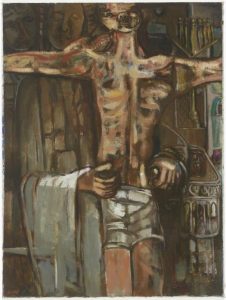In April 2019, Dr. Bridget Cooks and I had the privilege of conducting a series of oral history interviews with artist and educator David C. Driskell for the Getty Research Institute’s African American Art History Initiative. David and his wife, Thelma, welcomed us into their home, where we spent hours speaking with David about his singular life and extraordinary contributions to art and African American art history. It was a surreal experience to sit behind the camera and look around at beautiful works of art while David skillfully engaged us with stories from his life and work. In recounting his past, David employed accents and well-timed jokes that had us in stitches. It was a pleasure to watch a gifted storyteller at work.
One year later, I learned from Bridget that this kind, funny, and smart man had passed away from complications due to the coronavirus on April 1, 2020. In a year filled with so much loss and change, David’s passing still hit hard. With David’s passing, the world lost not only a bright personality, but also a brilliant mind who championed the field of African American art history. And despite the uncertainty of these early days of the pandemic, I am happy to say that the Oral History Center was able to expedite the finalization of David’s oral history transcript, which is now available to the public.
Now another April has arrived. At the Oral History Center our work remains remote, but people across the country have been vaccinated against the coronavirus, and there is hope that the end of the pandemic is in sight. It is past time to take stock and reflect on those we have lost and the stories that remain with us. For me, David Driskell’s interview is one such story with staying power.
David C. Driskell was an artist and professor of art. He was born in Georgia in 1931, but mainly grew up in North Carolina. Driskell graduated from Howard University with a degree in painting and art history in 1955, attended the Skowhegan School of Painting and Sculpture in 1953, and earned an MFA from Catholic University in 1962, as well as a study certificate in art history from Rijksbureau voor Kunsthistorische Documentatie in 1964. Beginning in 1955, he taught at several colleges, including Talladega College; Howard University; Fisk University; and the University of Maryland, College Park. His influential artwork includes Young Pines Growing, Behold Thy Son, Of Thee I Weep, and Ghetto Wall #2. Driskell has curated important shows highlighting African American art history, including Two Centuries of Black American Art and Hidden Heritage: Afro-American Art, 1800-1950. He also helped establish The David C. Driskell Center for the Study of Visual Arts and Culture of African Americans and the African Diaspora at the University of Maryland, College Park, in 2001. Find this interview and all our oral histories from the search feature on our home page. You can search by name, key word, and several other criteria.
Throughout his many years making art, David experimented with different media and subjects, often with the recurring theme of pine trees. Yet one of his most memorable pieces is Behold Thy Son from 1956, which is now at the Smithsonian’s National Museum of African American History and Culture. David painted this pietà – a subject in Christian art depicting the Virgin Mary cradling the dead body of Jesus – in response to the 1955 murder of Emmett Till. For many observers, this image captured the zeitgeist of the early Civil Rights movement.

Listen as David speaks about making this important piece:
When Bridget asked how David felt about Behold Thy Son over sixty years after painting it, he replied, “I think it is dated and tied to a time and period, but the fight goes on. It’s also showing you that time hasn’t changed that much. [Eric Garner and] ‘I can’t breathe.’ ” Indeed, the subject of violence against Black bodies remains tragically evergreen.
And yet, in part because of this turmoil for African Americans at midcentury, David found renewed artistic inspiration in the serenity of nature – especially pine trees. Listen as he explains this shift in his work:
David was indeed a talented artist and important educator, as Bridget eulogized so well in her obituary on ArtForum last year. But our oral history interviews with him also highlighted the fact that he was a deeply religious man, one who connected his spirituality and creativity with his passion for gardening. During an interview session after church on Palm Sunday, David said of these links between nature and religion, “From dust and dirt thou came, and so dust to dirt thou goest. I’ve got to be part of that process.”
He further explained:
“So gardening is to me like painting, in a way. It’s a part of the process of this creative spirit that I feel so close to. Can’t wait to get [to the house in Maine] and I often go to the garden before I go to the studio…Gardening is a part of my life. It’s a part of that kind of spiritual regeneration that comes with the natural process. It isn’t for me so much the biblical reference.”
As a further measure of the man, when we were wrapping up our final interview session, we asked David for his concluding thoughts, and he said, “Well, maybe the final say is none of this I could be doing without family.” He went on to praise his wife, Thelma, in particular for supporting his art career when it was just a dream.
To learn more about David C. Driskell’s extraordinary life and work, read his oral history transcript and watch his interview in full here, here, and here. Find this interview and all our oral histories from the search feature on our home page. You can search by name, key word, and several other criteria.